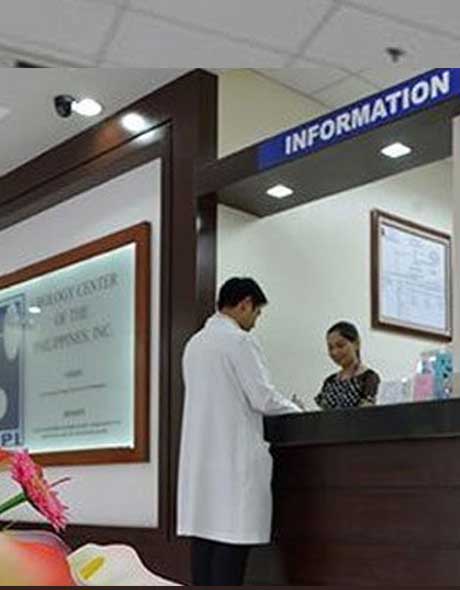UCPI - Our Services
Extracorporeal Shock Wave Lithotripsy (ESWL)
UROLITHIASIS
Archeological findings gave profound evidence that men suffered from kidney and bladder stones for centuries. Urolithiasis is the condition where urinary calculi or stones are formed or located anywhere in the urinary system. It is the process of stone formation within the kidney, bladder, and/or ureters. Formation begins from minute crystallized salts that bind together that later solidify. If the crystallized materials remain small enough, it will travel through the urinary tract and may spontaneously pass out unnoticed. (1)
When the urinary stone is large enough to cause an obstruction on the flow of urine, patients may experience unimaginable pain.
Urolithiasis is prevalent worldwide and it is considered third commonest urological problem (2). It is common in middle age persons, agewise peak incidence is in second to fourth decade (3), with a mean age of 29 years (4).
What are the symptoms?
Common symptoms of urinary stone disease include:
- Pain in the lower back, flanks or inguinal area
- Blood in the urine
- Fever/ Infections
- Nausea and vomiting
- Painful urination
How is the stone diagnosed?
Should you experience any of the symptoms listed above, visit your friendly urologist at The Urology Center of the Philippines for immediate consultation. Our experts will perform thorough physical examination. Laboratory and imaging modalities (CT Stonogram and Ultrasound) will also be performed to further assess the urinary stone.
The goal of any kidney stone surgical treatment is to achieve maximal stone clearance with minimal morbidity to the patient (5).
Treatment Options
1. ESWL- Extracorporeal Shockwave Lithotripsy
2. PCNL and Mini PCNL
3. RIRS- Retrograde Intrarenal Surgery

Extracorporeal shock wave lithotripsy (ESWL) is a non-invasive treatment of urolithiasis. It uses acoustic pulse to break a kidney stone into small pieces that can easily travel through the urinary tract and passes from the body.
Advances in ESWL have significantly decreased the indications for open stone surgery, which is now often a second- or third-line treatment option needed in 1.0-5.4% of cases only (6).
It is an effective procedure for treatment of patients with renal and ureteric stones (7). It is done as an outpatient procedure. You go home after the treatment and do not have to spend a night in the hospital.
Currently, The Urology Center of the Philippines, Inc. utilizes three ESWL machines. The Urology Center of the Philippines Hospital at Maginoo Street Diliman Quezon City has two (2) ESWL machine – a Dornier Compact Delta II and Dornier Compact Sigma. The Compact Delta II utilizes proven Dornier Electromagnetic Shock wave Emitter (EMSE) technology to deliver consistent, reliable energy. The Stone Unit-Manila Doctors Hospital has also the Dornier Compact Delta II.
Preparations For ESWL
- No smoking 24 hours before the procedure
- No driving 24 hours after the procedure
- Take the Anti-Hypertensive medications with 2 tablespoons of water
- Don`t take Anti-Diabetes medications once fasting starts
- No Aspirin, anti-coagulant medicines 1 week before the procedure
What To Expect After The Procedure
- After the treatment you might experience the following:
- For any unusual problems, please consult your doctor
| PAIN | Patient may feel sore due to passage of stone fragments. If such is unbearable despite of pain killers, please consult your physician |
| FEVER | Patient may have slight fever. If it goes beyond 38C, see your doctor for appropriate treatment. |
| STONE PARTICLES | For a week after the procedure, strain your urine and save stone fragments for identification of its composition. Please send your stone fragments to the laboratory for stone analysis. This will help you and your doctor in post ESWL follow-up care. |
| BLOODY URINE | This is usually expected for a day or two. |
| FLUIDS | Drink 2-3 liters or 10-15 glasses of water a day as this will help clear the urine and pass out stone fragments. |
| ACTIVITIES | Normal activities may resume after a day |
| DIET | Dietary advice may be given on a case to case basis depending on stone composition. Your urologist will be more than willing to discuss matters with you. |
| X-ray/ Ultrasound | Is done 1-3 weeks after the procedure to assess progress in stone disintegration. |
Referrences
1. Lopez M, et.al. History, Epidemiology and Regional Diversities of Urolithiasis. Pediatr Nephrol (2010) 25:49–59
2. Tanogho EA, McAninch JW, (edi). Urinary stone disease. Smith's general urology. 15th ed. San Francisco: McGrawHill, 2000: 291-320.
3. Menon M, et.al. Urinary lithiasis. In: Walsh PC, Retik AB, Vanghan ED, Wein AJ, (edit). Campbell' urology. 7th ed. Philadelphia: WB Saunders, 1998. 2659-734.
4. Arain GM, Malik SA. Urinary calculas disease: a study of 267 cases at Sir Ganga Ram Hospital Lahore over 2 years. Biomedica 1997; 13: 38-41.
5. Paterson R, et.al. Shock Wave Lithotripsy Monotherapy For renal Calculi Int Braz J Urol Vol. 28 (4): 291-301, July - August, 2002
6. Assimos DG, Boyce WH, Harrison LH, et al. The role of open stone surgery since extracorporeal shock wave lithotripsy. J Urol 1989 Aug;142(2 Pt 1):263-7.
7. Butt A., et.al. Extracorporeal Shock Wave Lithotripsy JCPSP 2005, Vol. 15 (10): 638-641

